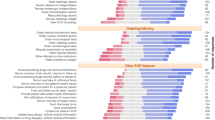Abstract
The study objective was the development and content evaluation of the paper-based Hajji Health Record (PHHR) instrument to make it appropriate for developmental phases of web based electronic Hajji (Pilgrim) Health Record (WEHHR) implementation. A qualitative and quantitative survey was done on 13 December 2008G in Alnoor Specialist Hospital, Makkah, Saudi Arabia. Twenty-two physicians of 19 countries were given a preliminary questionnaire containing basic sociodemographic information, followed by Hajjis’ health information sheet (HHIS) with a sample scenario of a case history. A structured evaluation questionnaire about HHIS was given afterwards. Five point Likert scaling was used starting from strongly agree to strongly disagree as 1 to 5. Data was analyzed by using SPSS programme version 16. Two tailed p-value <0.05 was considered as significant. Mean age was 48.6 years with range (35–64). Specialists were 10(45.5%) and teaching hospitals’ physicians were 11(50%). Twelve (54.5%) physicians had concept about EHR, while the same number had their Hajjis’ health record but only 33.3% (4/12) had sufficient health information. Response rate was 91.9% with average rating of 2.2 ± 1. Agreement response (78.8%) was noted for “medical history” category followed by “medication history” (76.2%). Average rating of consultants was (2 ± 0.88), while specialists, residents and general practitioners had 2.3 ± 1.2, 2.7 ± 1, 2.1 ± 0.58, respectively. Physicians without EHR concept had average rating 2.1 ± 1.16 than other group (2.3 ± 0.92). Majority of physicians were specialists. Overall response rate was superb with agreement response. No significant difference in rating was found among all categories of physicians.
Similar content being viewed by others
References
Ahmed, Q. A., Arabi, Y. M., and Memish, Z. A., Health risks at the Hajj. Lancet 367(9515):1008–15, 2006.
Hillestad, R., Bigelow, J., Bower, A., Girosi, F., Meili, R., Scoville, R., and Taylor, R., Can electronic medical record systems transform health care? Potential health benefits, savings, and costs. Health Aff 24(5):1103–1117, 2005.
Einbinder, J. S., and Bates, D. W., Leveraging information technology to improve quality and safety. Methods Inf Med 46(suppl 1):22–29, 2007.
Chaudhry, B., Computerized clinical decision support: will it transform healthcare? J Gen Intern Med 23(suppl 1):85–87, 2008.
Chaudhry, B., Wang, J., Wu, S., Maglione, M., Mojica, W., Roth, E., Morton, S. C., and Shekelle, P. G., Systematic review: impact of health information technology on quality, efficiency, and costs of medical care. Ann Intern Med 144(10):742–752, 2006.
Al-Otaibi FS. Towards an electronic health record in kingdom of Saudi Arabia[online]. Paper presented at: fourth regional conference on e-Health. 2005 June-[Cited 2009 April 13]. Available from: www.emro.who.int/his/ehealth/Presentations/Iran04/SaudiArabia.pps
Sánchez JL, Savin S, Vasileva V. Key success factors in implementing electronic medical records in university hospital of rennes [internet]. Rennes (FR): University hospital. 2005 June 23[cited 2009 August 25]. 10–13 p. Available from: http://www.europhamili.org/protect/media/27.pdf
Geiger, G., Merrilees, K., Walo, R., Gordon, D., and Kunov, H., An analysis of the paper-based health record: information content and its implications for electronic patient records. Medinfo 8(Pt 1):295, 1995.
Lober WB, Zierler B, Herbaugh A, Shinstrom SE, Kim EH, Kim Y. Barriers to the use of a Personal Health Record by an Elderly Population. AMIA Annu Symp Proc. 2006; 514–518.
Tang, C. P., Ash, J. S., Bates, D. W., Overhage, J. M., and Sands, D. Z., Personal health records: definitions, benefits, and strategies for overcoming barriers to adoption. Jour of Am Med Inform Assoc 13(2):121–26, 2006.
Acknowledgment
We are thankful to Dr. Khalid Obeid Dhafar (Director General of health affairs, Makkah Region, KSA) and Dr. Hashim Taib (Director of Hajj Medical Missions, Makkah, KSA) for providing us valuable information about Hajj mission physicians and helping in arrangement of physicians’ meeting and place for survey.
Financial support was given by Ministry of Health Makkah Region.
We declare that we have no financial or personal relationship(s) which may have inappropriately influenced us in writing this paper.
Author information
Authors and Affiliations
Corresponding author
Appendix I
Appendix I






Rights and permissions
About this article
Cite this article
Shaker, H.A., Farooq, M.U. Usability Evaluation of Paper-based “Hajji” Health Record Format. J Med Syst 36, 853–863 (2012). https://doi.org/10.1007/s10916-010-9549-1
Received:
Accepted:
Published:
Issue Date:
DOI: https://doi.org/10.1007/s10916-010-9549-1




